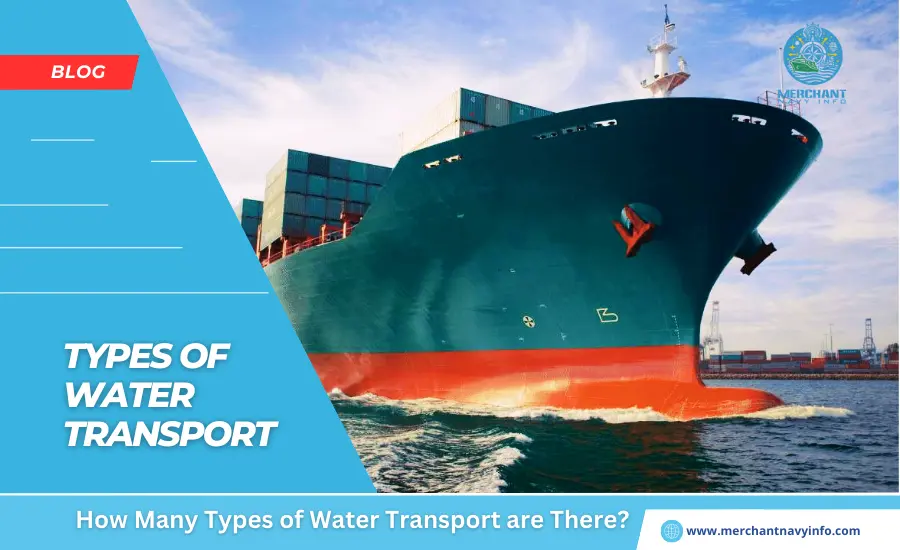
There are three main means of transportation: air, water, and land. While ground transportation includes everything from cars to buses, trucks to scooters, and bicycles to trains, air transportation primarily consists of planes and helicopters. When we think of water transportation, the only image that comes to most of our minds, especially those who aren’t in the industry, is that of a large ship with large chimneys and spewing clouds, roughly resembling the Titanic.
There is a cloud of black smoke, and we walk slowly in the middle of deep blue water. For those of us working within this field, this picture is more detailed and shows different characteristics of different types of ships. Now, when it comes to water transportation, there can be many different classifications beyond the types of boats and watercraft. Let’s take a look at some of them.
Type Of Water Transportation Based on the Route or Type of Waterway
Used for transportation. Based on the waterways, bodies of water, and routes that serve sea transport or water transport, water transport or sea transport can be classified into the following types:
River
This is a local form of water transport used for river transport. As you know, rivers are shallow freshwater bodies of water in the country and can span various lengths. Additionally, river transport falls under the jurisdiction of inland waterways. This means that waterways or bodies of water providing certain traffic are limited to shallow waters only, subject to local considerations. Inland transport is usually intended only for short-distance movement from one place to another. Similarly, river transportation includes small to medium-sized vessels intended for both commercial transportation and public and personal transportation over various distances within the geographic boundaries of a country or state.
This can range from a simple, unassuming fishing boat basking in the soft evening sun to a medium-sized cargo ship transporting food and manufactured goods perhaps 1,000 to 2,000 kilometres from one corner of the country. Another one has been delivered. Types of river transport include conventional cargo ships, freighters, fishing boats, barges, speedboats, steamers, trawlers, tenders, pleasure yachts, fast-planning vessels, river ferries, etc. In water, all river vessels are classified as shallow draft vessels.
Lake
In a technical sense, a lake is an enclosed or confined body of water with different surfaces. This means they range from the size of Lake Bhopal in India to the size of Lake Superior in the United States, the world’s largest freshwater lake. They vary accordingly, not only in area but also in depth. Transportation options and types also depend on the extent and size of the lake. However, for practical reasons, this is also taken into account when studying shallow draft inland waterways.
Coast
This falls under the scope of ocean transport. Domestic shipping includes ships that sail close to the coast. This includes both commercial and passenger ships.
International And Intercontinental
Most maritime traffic is considered international or intercontinental travel. International travel may occur between two countries within the same continental border (for example, between Germany and Sweden, Italy and Greece, etc.), whereas intercontinental travel involves travel across the large ocean that separates two continents.
Polar Ships
classified into specific ship classifications. Polar ships are designed and built to operate in icy oceans with layers of ice, ice floes, icebergs, and plates. Because they often have to overcome ice forces and higher fluid dynamics, they are highly structurally reinforced and equipped to withstand several days of adverse cold weather conditions. Icebreakers belong to the top category of polar vessels and are designed to break through thick ice, often clearing the way for a following tow vessel.
Types Of Water Transportation Based on Ownership and Use
Commercial
These vessels account for the highest proportion of maritime transport. All inland or ocean-going vessels intended for commercial, commercial, or industrial purposes are called merchant ships. Merchant vessels include everything from oil barges to bulk carriers, fishing trawlers to container ships, and rice carriers to LPG tankers. All merchant ships are important and essential links in global trade and supply chains at various levels. Merchant ships are privately or government-owned.
Passenger and Public Vessels
This includes vessels intended for the carriage of passengers as public transport on water. As already mentioned, after the recent aviation monopoly, the usefulness of ships in passenger transport has declined significantly over time. However, they are still used by vacationers and travellers in many places for pleasure and luxury recreation. Shallow-water public transport is still very popular around the world, especially for short-distance transport, such as water taxis, river cruises, ferries, steamboats and launches.
Privately Owned Ships
These small to medium and sometimes larger ships are exclusively privately owned. Ownership may be limited to a single individual or an entity, such as an organization or company. However, as mentioned above, civilian vessels should not be confused with privately owned merchant vessels. Merchant ships are usually larger (although smaller ships also exist) and are part of a larger fleet of a shipping or the international fleet transport organization that specializes solely in cargo transport and supply chains. It operates 24 hours a day at different distances and transports or transports different goods and supplies in different quantities.
Defence:
These ships also occupy important positions, especially in the world fleets of superpowers. However, all countries, regardless of size, population, and so-called world dominance, have their own navies as part of their military capabilities.
Special Vessels
These vessels are research or exploration vessels used primarily for scientific purposes. These may be owned by governments or operated by institutions or companies.
Types Of Water Transport Based on Diving Ability
Surface Ships
All types of ships and boats that float on water are surface ships. These can be further classified into the following types: displacement machines, planar machines, and semi-planar machines.
Submarines and Submersibles:
As you already know, these ships remain submerged below a certain height, which allows for a variety of readings of submarines and submersibles.










